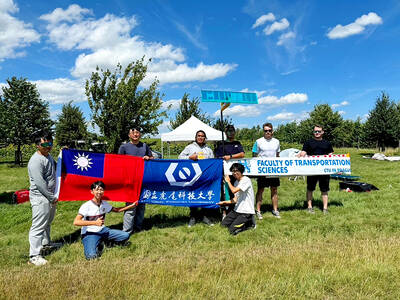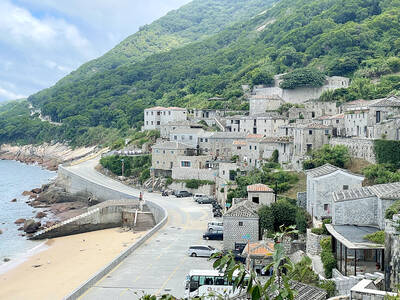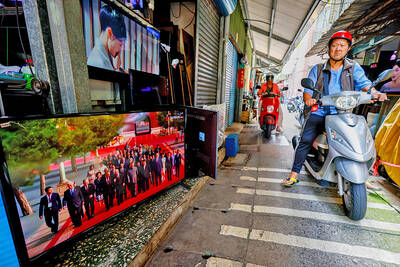President Ma Ying-jeou (馬英九) yesterday praised the Kinmen Agreement signed by Taipei and Beijing 20 years ago for establishing a way to peacefully resolve cross-strait issues, adding that this model continues to be used, as is shown by the signing of the Economic Cooperation Framework Agreement (ECFA).
The Kinmen Agreement was signed by the Red Cross from both sides of the Taiwan Strait on the Kinmen islets on Sept. 12, 1990. Representatives discussed the thorny issue of repatriating criminals, smugglers or fugitives under the spirit of humanity and practicality.
“This was the first time authorities on both sides of the Taiwan Strait openly resolved problems in a peaceful manner,” Ma said in his weekly video address.
“It set the model of cross-strait negotiations: seeking common ground while reserving differences,” he said.
In the video, Ma conversed with Red Cross Society of the Republic of China head C.V. Chen (陳長文) to mark the 20th anniversary of the accord.
Chen said once the main direction of bilateral negotiations was set, the rest was easy.
If there were any difficulties when the two sides inked the 1990 agreement, Chen recalled there were two technical problems both sides needed to iron out.
First was the title of the signatories, he said, and the two sides decided to steer clear of politically sensitive terms such as the Republic of China or People’s Republic of China.
“Had we dwelled on that issue, we would not have accomplished anything,” he said.
Second was the year appearing on the pact, he said. Chen said the two sides decided that Taiwan used the Republic of China calendar year, while China used the Gregorian calendar.
Ma recognized both sides for making efforts to “face reality, shelve disputes and create a win-win scenario.”
He added he was glad that such a model continues to be used today and cited the ECFA as the most recent example.

The Chinese military has built landing bridge ships designed to expand its amphibious options for a potential assault on Taiwan, but their combat effectiveness is limited due to their high vulnerability, a defense expert said in an analysis published on Monday. Shen Ming-shih (沈明室), a research fellow at the Institute for National Defense and Security Research, said that the deployment of such vessels as part of the Chinese People’s Liberation Army (PLA) Navy’s East Sea Fleet signals a strong focus on Taiwan. However, the ships are highly vulnerable to precision strikes, which means they could be destroyed before they achieve their intended

The Taiwan Experience Education Program (TEEP) has funded short-term internships in Taiwan for more than 4,500 young people from more than 40 countries since 2015, with the goal of attracting and retaining international talent, the Ministry of Education said yesterday. Fifty-five colleges launched 514 projects this year, including in fields such as semiconductors, artificial intelligence, medicine and biotechnology, green energy, and sustainability, it said. The program provides research and practical internships in Taiwan for two to six months, and offers cultural exchange and networking opportunities, the ministry said. For example, National Formosa University’s Embedded System and Autopilot Laboratory developed two solar-powered drones in

GLOBAL: Although Matsu has limited capacity for large numbers of domestic tourists, it would be a great high-end destination for international travelers, an official said Lienchiang County’s (Matsu) unique landscape and Cold War history give it great potential to be marketed as a destination for international travelers, Tourism Administration Director General Chen Yu-hsiu (陳玉秀) said at the weekend. Tourism officials traveled to the outlying island for the Matsu Biennial, an art festival that started on Friday to celebrate Matsu’s culture, history and landscape. Travelers to Matsu, which lies about 190km northwest of Taipei, must fly or take the state-run New Taima passenger ship. However, flights are often canceled during fog season from April to June. Chen spoke about her vision to promote Matsu as a tourist attraction in

Taipei resident Mu Chu-hua caught some glimpses of China’s mighty military parade on YouTube on Wednesday. As she watched hypersonic missiles roll down Beijing’s Changan Avenue and troops march in lockstep, she did not feel like they posed a threat to Taiwan. Mu, a 69-year-old retiree, said she saw the parade as simply a way for Chinese President Xi Jinping (習近平) to “say thank you to the troops.” “I thought it was quite normal,” she said. “It was very cool.” China’s military parade commemorating the end of World War II was being watched internationally for insights into Beijing’s military advances and its show